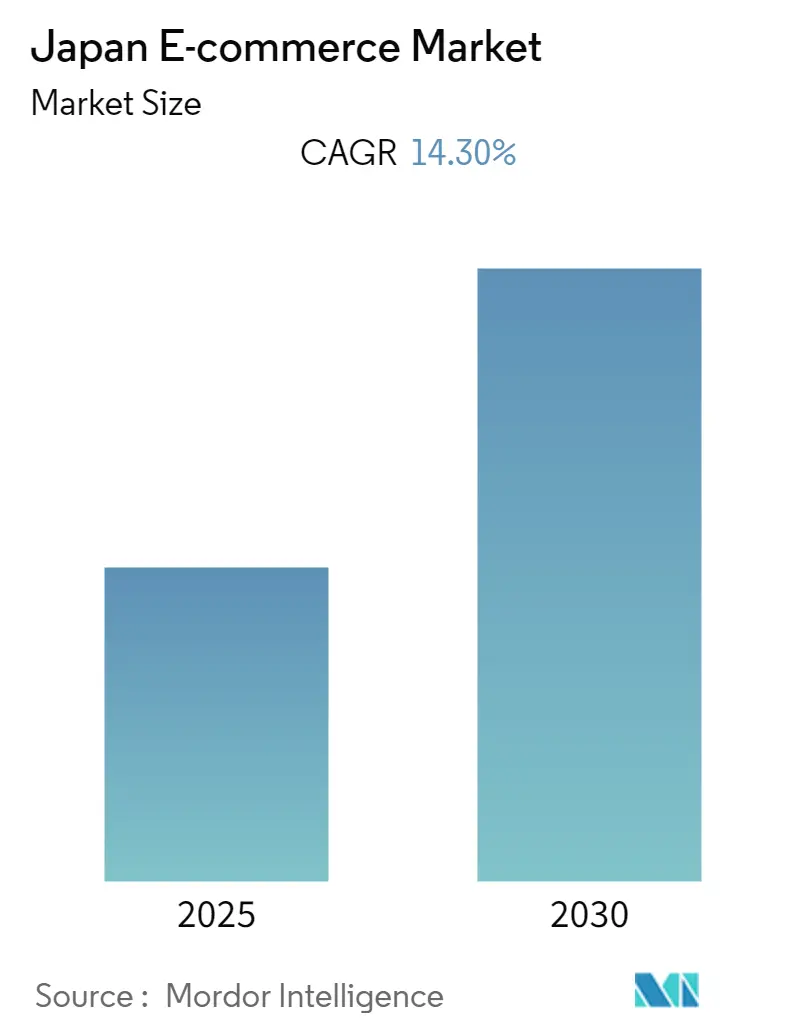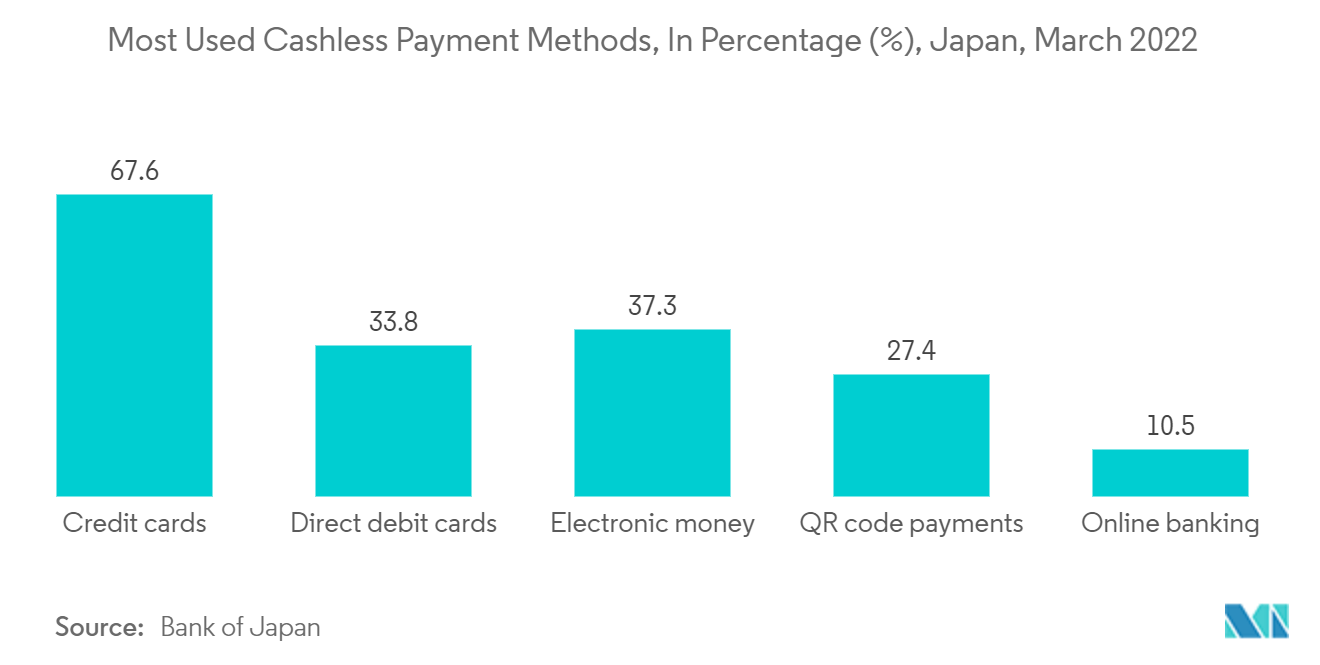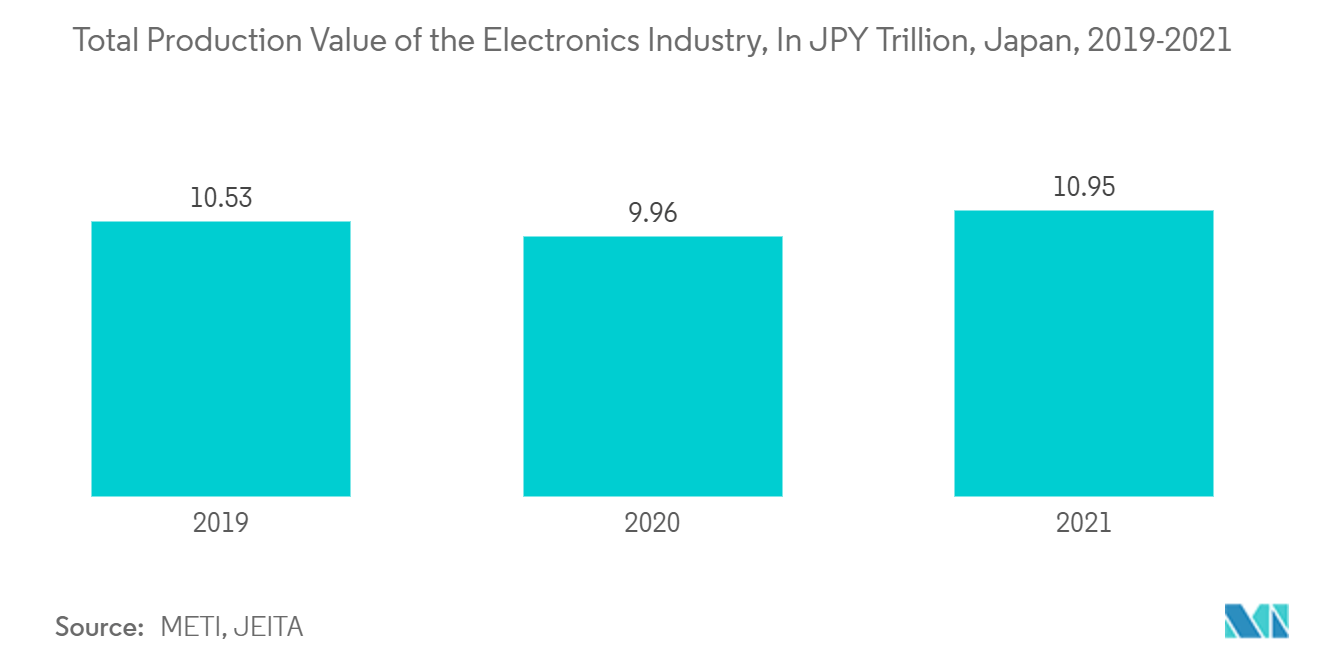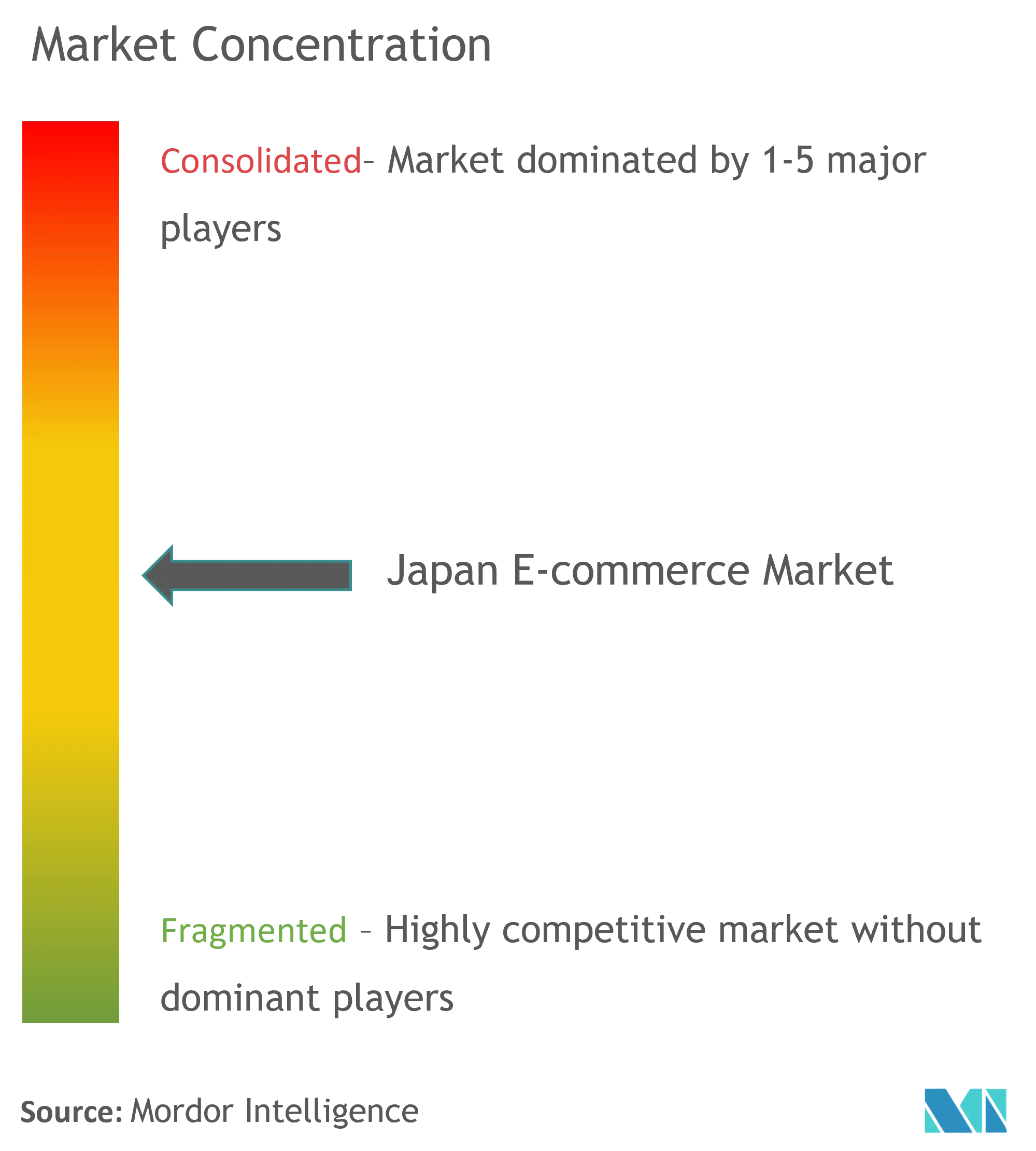
Japan E-commerce Market Analysis
The Japan E-commerce Market is expected to register a CAGR of 14.3% during the forecast period.
- The E-commerce market in Japan is going through significant transformational change as the Japanese are shifting from traditional brick-and-mortar stores to online businesses. E-commerce companies in the region are benefiting from high urban density, technically savvy customers, and a developed economy and further attracting the E-commerce market in the region.
- Along with this, the distribution channel in-country is highly developed and connected, and the small size of the country makes shipping and delivery more convenient at a faster speed, which is also boosting the E-commerce market in Japan.
- Digital advertising in the region is further driving the E-commerce market in the country. Search and display ads are mainly used by brands and advertising agencies primarily with product feeds and shopping ads usually used by major E-commerce companies such as Rakuten, Yahoo! Auction Shopping, and Amazon Japan.
- Furthermore, social commerce is on the rise and is further propelling the growth of the e-commerce market in the region. E-commerce companies use sponsored content, working with influencers and celebrities, and ads on social media to promote products and services in Japan. While Japan has global social media platforms such as Twitter and Facebook, its popularly used social media network is Line, an app similar to WhatsApp with multiple features.
- However, specific laws and regulations pertaining to E-commerce can limit the growth of the E-commerce market in the region. For instance, the Act on Improvement of Transparency and Fairness in Trading on Specified Digital Platforms will require e-Commerce platforms to submit an annual report to METI on their business practices. METI will subsequently solicit comments from merchants, conduct reviews, and publish the results. U.S. firms Amazon and Apple and Japanese firms Rakuten and Yahoo-Japan are among those affected by this law.
- During the COVID-19 outbreak, although Japan hasn't seen strict lockdowns compared to Europe or North America, the multiple states of emergency and the promotion of staying at home have had people adopting online shopping at an unprecedented rate. As a result, more people switched to digital platforms, media, and apps, ordering food delivery and everyday items online.
Japan E-commerce Market Trends
Rising Adoption of Card Payments and M-commerce to Boost the E-commerce Market
- When it comes to online shopping, Japanese shoppers prefer card payment mainly through credit cards because of the ease of convenience various E-commerce platforms provide on card payments, such as easy checkout solutions, discounts, gift vouchers, and additional rewards and benefits. Visa, Mastercard, and JCB are the most widely used and accepted cards in online shopping in Japan. These type of easy-to-go payment solutions is further expected to boost the E-commerce Market.
- Furthermore, many E-commerce companies further provide the option for saving the card feature, which is time-saving for further online transactions in the future. However, digital payment solutions are rising at a faster rate in the region, with many E-commerce market Players launching wallets such as Rakuten Pay. Still, card payment will remain the preferred option for E-commerce in the coming years.
- Moreover, with high mobile and internet penetration, Mobile commerce is rising rapidly in the region. As reported by International Telecommunication Union, there were 152.03 mobile subscriptions registered for every 100 people in 2020 in Japan. This has led to the rise of M-commerce in the region and further drives the E-commerce market.
- The trend of M-commerce has increased in the region over the past few years due to the various benefits associated with M-commerce. With sustained growth in mobile transactions in Japan and in-app purchases provided by most E-commerce companies such as Amazon Japan and Yahoo! Japan, and Rakuten, M-commerce is further expected to grow over the forecast period.
Consumer Electronics Segment Hold the Largest Share
- The consumer electronics product segment holds the largest share in the E-commerce market in Japan owing to the enhanced digital landscape in Japan, ease of convenience offered through online sales in terms of review and return policies, technology-savvy consumers, and the increasing focus of E-commerce companies on establishing and expanding their digital services.
- The data reported by the Ministry of Economy, Trade, and Industry (METI) and the Japan Electronics and Information Technology Industries Association (JEITA), the total production value of the electronics industry in Japan reached close to JPY 11 trillion in 2021. The value was JPY 10.53 trillion in the year 2019. The industry encompasses consumer electronic equipment, industrial electronic equipment, as well as electronic components and devices.
- Japan's twice-yearly bonus culture for salaried people boosts E-commerce sales. The summer bonus, in particular, is associated with an uplift in luxury goods, travel, and consumer electronic purchases. Moreover, the major players in the region, which hold a significant amount of share, offer various discounts and offers on the purchase of consumer electronics during these sales.
- As reported by the Ministry of Economy, Trade, and Industry (METI), E-commerce sales are high for domestic electrical appliances, AV equipment, and peripherals and PCs because, with domestic electrical appliances, AV equipment, and peripherals and PCs, the product specifications are clear, and it is easy to understand the details and features of the products by researching (searching on the internet for) them in advance. In this regard, they are highly compatible with E-commerce. The aforementioned factors are further expected to drive the E-commerce market over the forecast period.
Japan E-commerce Industry Overview
The Japan E-commerce market appears to be moderately consolidated as few players currently dominate the E-commerce market. Major players in the Japan E-commerce market are adopting strategies like acquisitions and partnerships to expand their reach in the region. Some of the major players in the E-commerce market are Rakuten Group, Inc., Amazon.com, Inc., DMM.com, Yahoo! Japan Corporation, and Mercari, Inc.
- April 2022 - Japanese apparel brand Uniqlo announced to launch of a new feature for its E-commerce site that will award customers with a donation by the brand, made on their behalf, to an organization. The Buy with Purpose feature, which will be present on the retailer's app and online website, will be available for sustainably made styles, such as Uniqlo's BlueCycle Jeans.
- April 2022- Westlake Akishima, a leading supplier of specialty stabilizers for the PVC industry based in Tokyo, introduced a new E-commerce platform to provide its customers with a secure and convenient online buying experience. The platform, built by the technology provider Agilis Chemicals, offers a complete set of sales and marketing functions to support fast and easy product search, order placement, and quick reordering.
Japan E-commerce Market Leaders
-
Rakuten Group, Inc.
-
Amazon.com, Inc.
-
Yahoo! Japan Corporation
-
Mercari, Inc.
-
DMM.com
- *Disclaimer: Major Players sorted in no particular order
Japan E-commerce Market News
- February 2022 - Rakuten, a key vendor in Japan's E-commerce company, launched its own NFT platform for the sale and trade of virtual assets in a bid to cash in on the crypto sector. The company said its platform also features an ability for IP holders to build their own websites supporting the issuance and sale of NFTs.
- November 2021 - Forest, a Japanese E-commerce aggregator, announced that it had raised approximately USD 8 million in a seed round led by The University of Tokyo Edge Capital Partners and Nordstar Partners. The startup will use the new capital to acquire more than 300 Japanese E-commerce brands that have been carefully crafted and curated by entrepreneurs. Forest will apply digital marketing strategies at scale, optimize sales and enhance inventory planning through data analytics, as well as support cross-border E-commerce expansion.
Japan E-commerce Industry Segmentation
E-commerce or electronic commerce is the purchasing and selling of goods or services on the internet. It encompasses various data, systems, and tools for online buyers and sellers, including mobile shopping and online payment encryption. Most businesses with an E-commerce presence use an E-commerce store or an E-commerce platform to conduct online marketing and sales activities.
The Japan E-commerce Market is Segmented into B2C E-commerce (Beauty and Personal Care, Consumer Electronics, Fashion and Apparel, Food and Beverage, Furniture and Home), and B2B E-commerce.
| By B2C E-commerce | Market Size (GMV) for the Period of 2017-2027 | ||
| Market Segmentation - by Application | Beauty and Personal Care | ||
| Consumer Electronics | |||
| Fashion and Apparel | |||
| Food and Beverages | |||
| Furniture and Home | |||
| Others (Toys, DIY, Media, etc.) | |||
| By B2B E-commerce | Market Size for the Period of 2017-2027 | ||
Japan E-commerce Market Research FAQs
What is the current Japan E-commerce Market size?
The Japan E-commerce Market is projected to register a CAGR of 14.3% during the forecast period (2025-2030)
Who are the key players in Japan E-commerce Market?
Rakuten Group, Inc., Amazon.com, Inc., Yahoo! Japan Corporation, Mercari, Inc. and DMM.com are the major companies operating in the Japan E-commerce Market.
What years does this Japan E-commerce Market cover?
The report covers the Japan E-commerce Market historical market size for years: 2019, 2020, 2021, 2022, 2023 and 2024. The report also forecasts the Japan E-commerce Market size for years: 2025, 2026, 2027, 2028, 2029 and 2030.
Our Best Selling Reports
Japan E-commerce Industry Report
Statistics for the 2025 Japan E-commerce market share, size and revenue growth rate, created by Mordor Intelligence™ Industry Reports. Japan E-commerce analysis includes a market forecast outlook for 2025 to 2030 and historical overview. Get a sample of this industry analysis as a free report PDF download.






